Cat’s pollinator garden with a canyon view
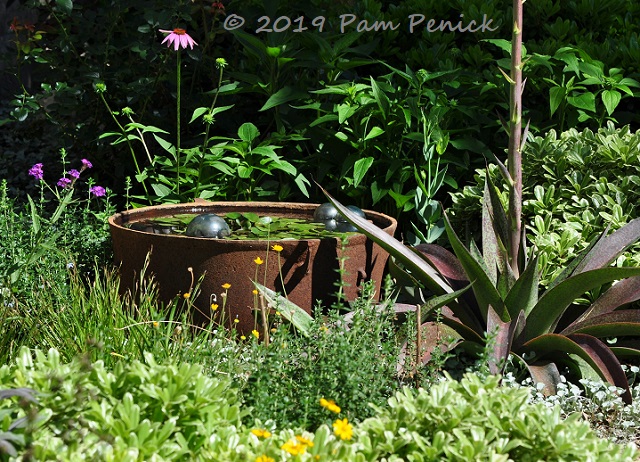
Three years ago my friend Cat Jones (check out her IG and blog) and her husband, Derrick, newly empty nesters, sold their house and Cat’s lovely garden and moved to a different home in their Steiner Ranch neighborhood, not to downsize but — fellow gardeners, can you relate? — to upsize their lot.
A canyon view in the backyard, perfect for summer sunset-watching, sold them on the house. Out front, Cat has been steadily turning the standard lawn with foundation shrubs into a beautiful pollinator garden with a low-profile evergreen backbone.
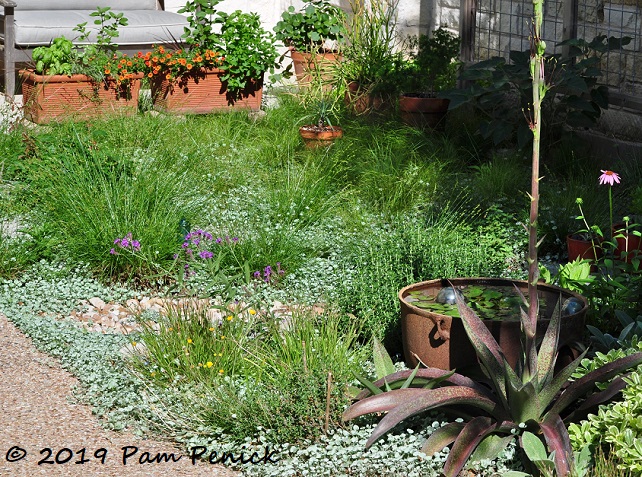
Cat is not afraid to take risks, like this Berkeley sedge and silver ponyfoot meadow in a sunny spot by the front door. She punctuates the green-and-silver combo with a rusty basin she’s turned into a tiny pond, complete with water lily and floating steel balls. With chocolate-spotted, fleshy leaves, a flowering ‘Macho Mocha’ mangave is the perfect companion.
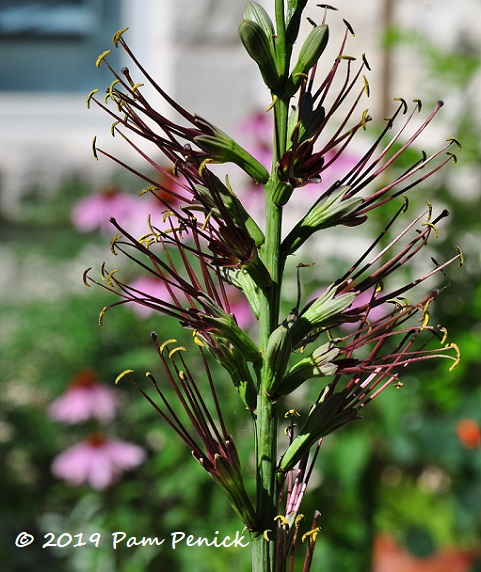
Detail of the ‘Macho Mocha’ mangave flower spike
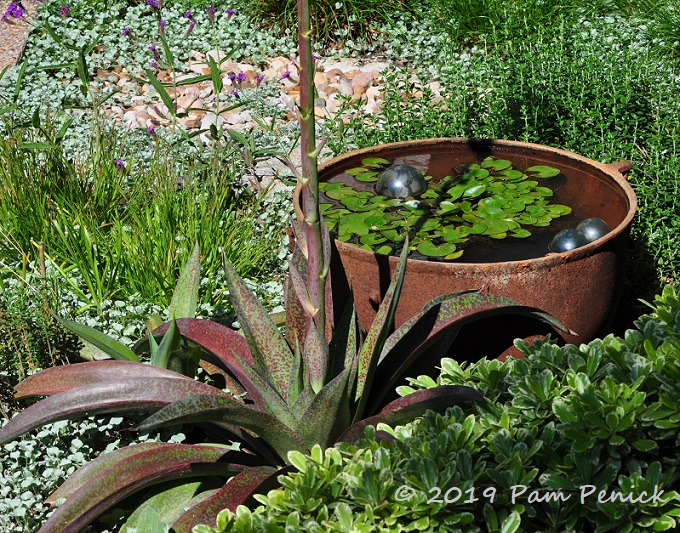
She says she didn’t plan this combo, but Cat has an artistic eye for what works together, and this is perfection. Rusty-spotted mangave with rusty vessel, and silver ponyfoot with stainless steel floating balls in the pond.
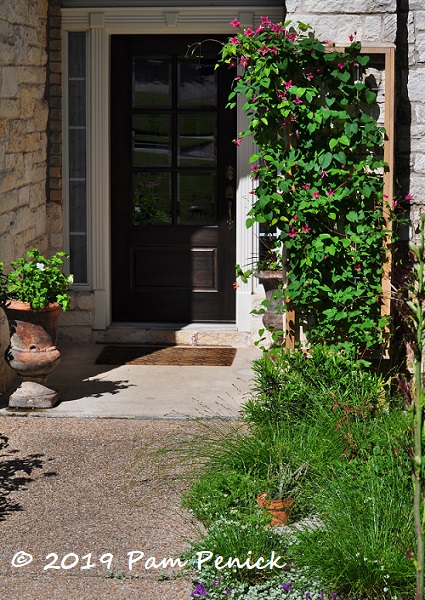
Derrick constructed cedar and hog wire trellises for vertical gardening by the front porch.
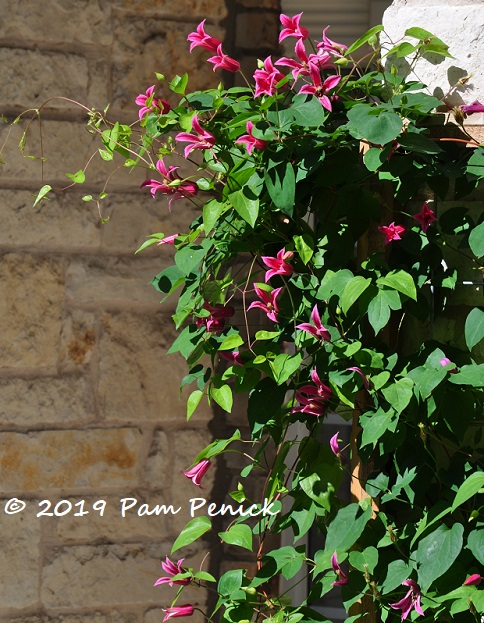
‘Princess Diana’ clematis cloaks this trellis.
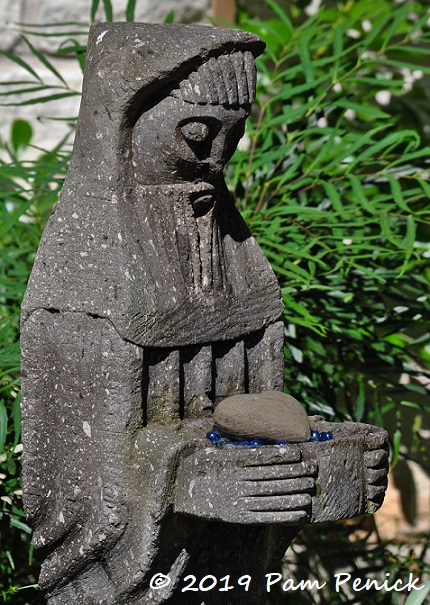
I love this Celtic figure cradling a bowl of blue glass beads and a stone heart.
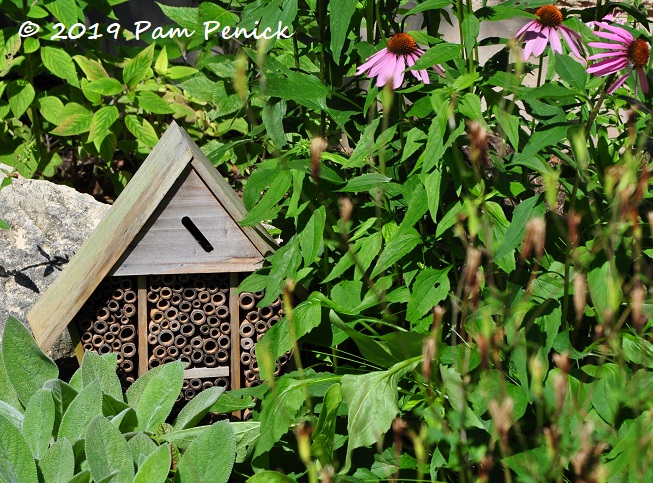
A bee hotel for solitary native bees nestles in a patch of purple coneflower.
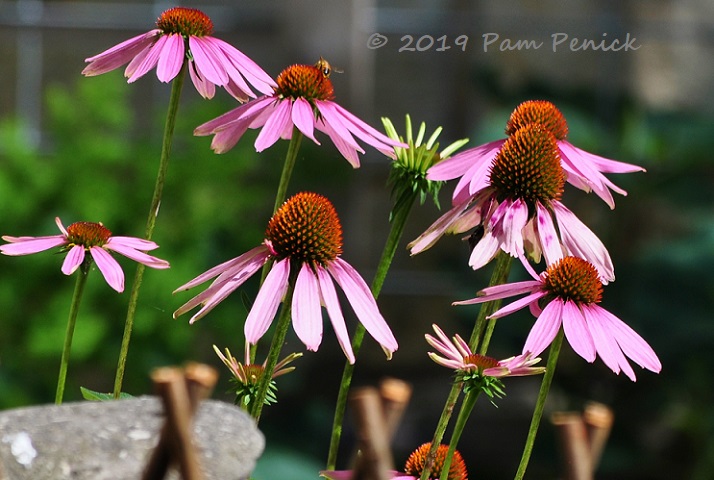
A honeybee enjoys the coneflowers too.
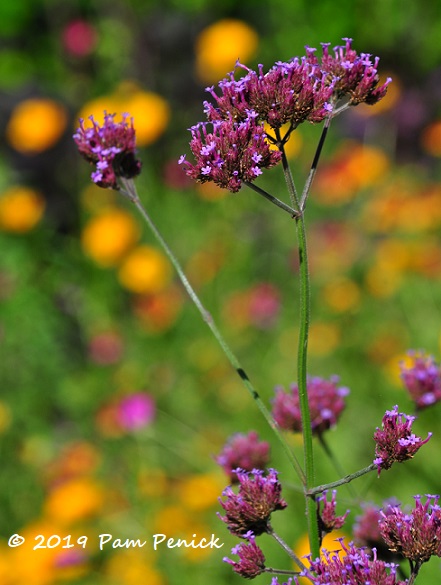
In a hot and sunny strip along the driveway, Cat planted flowering perennials and annual wildflowers including tall verbena…
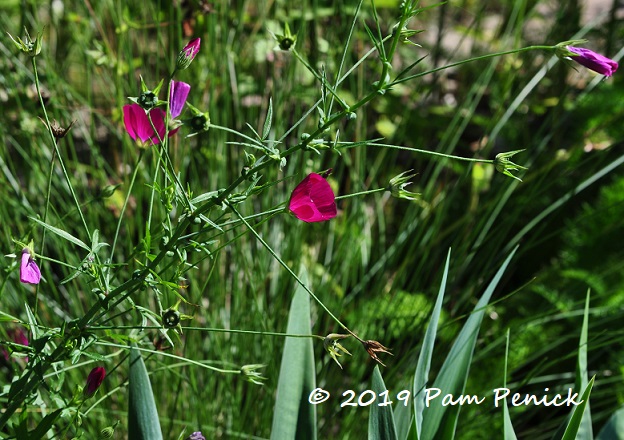
…tall winecup (I’d never seen the tall variety before)…
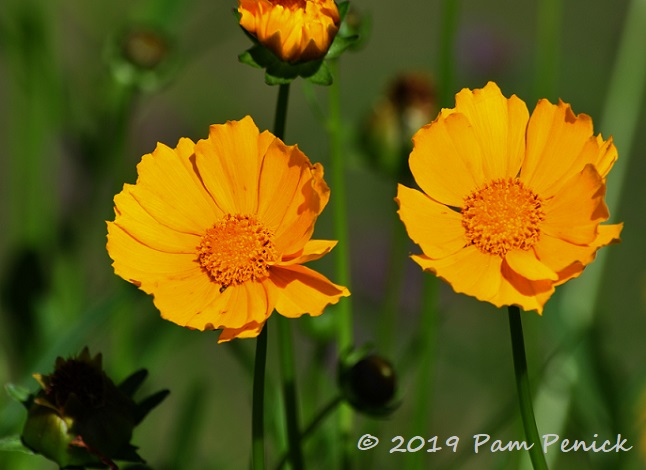
…coreopsis…
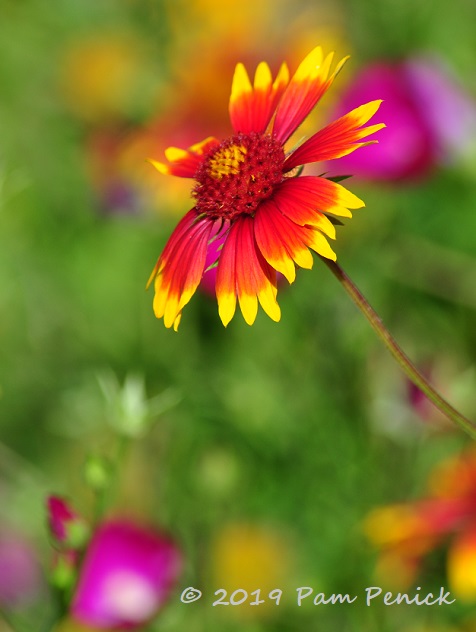
…blanketflower…
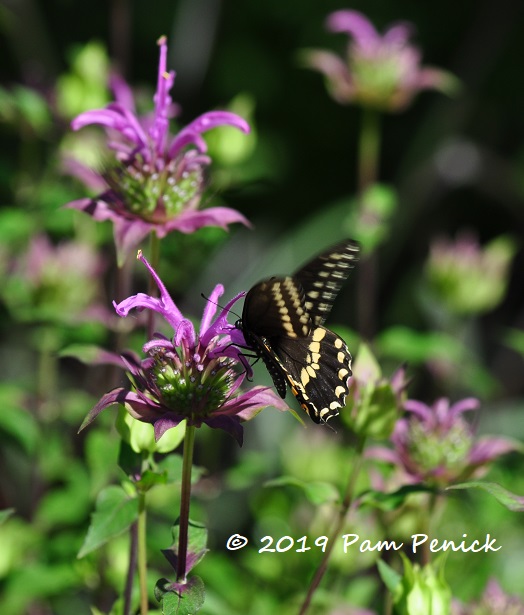
…and ‘Peter’s Purple’ monarda. A swallowtail butterfly skipped from one flower to the next, sipping nectar.
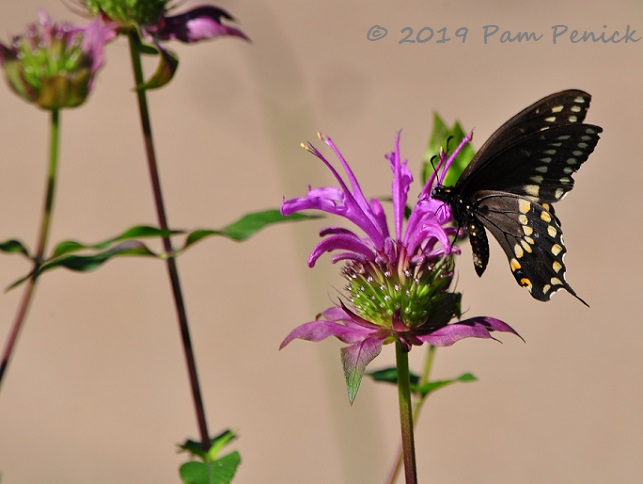
Swallowtail and ‘Peter’s Purple’ monarda, aka bee balm
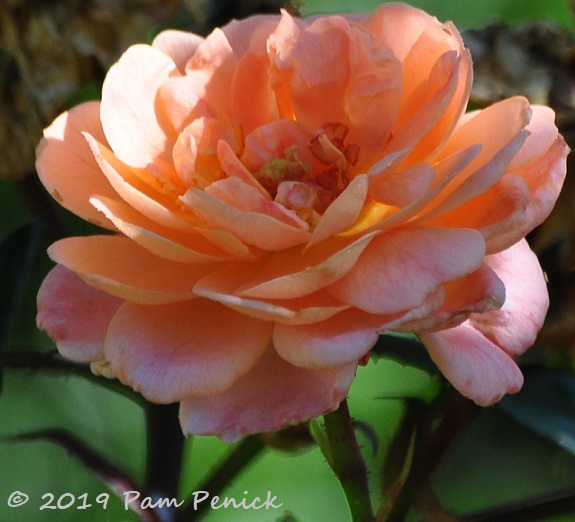
An apricot rose
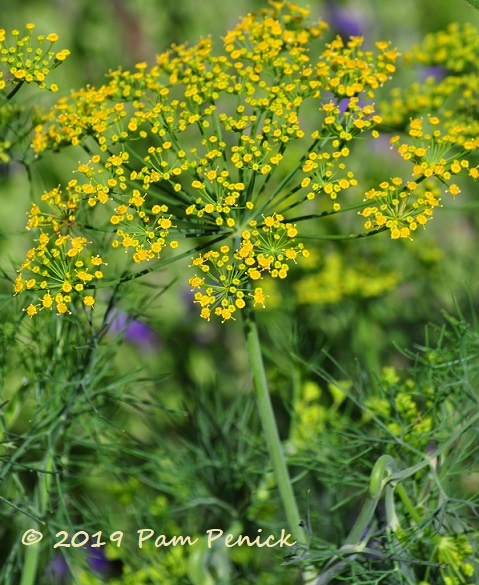
Flowering dill
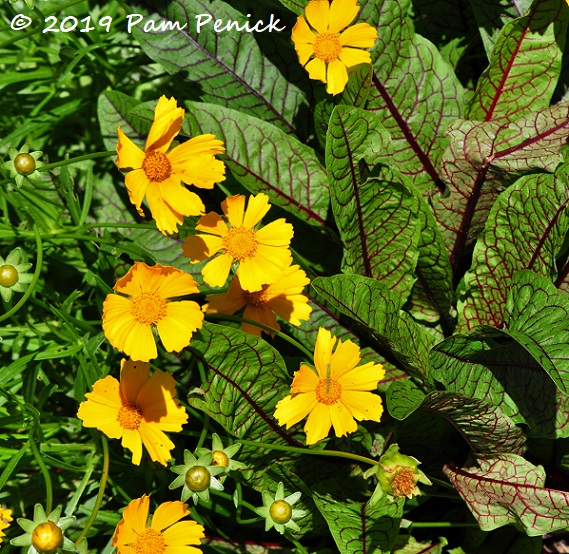
Lanceleaf coreopsis and red-veined sorrel
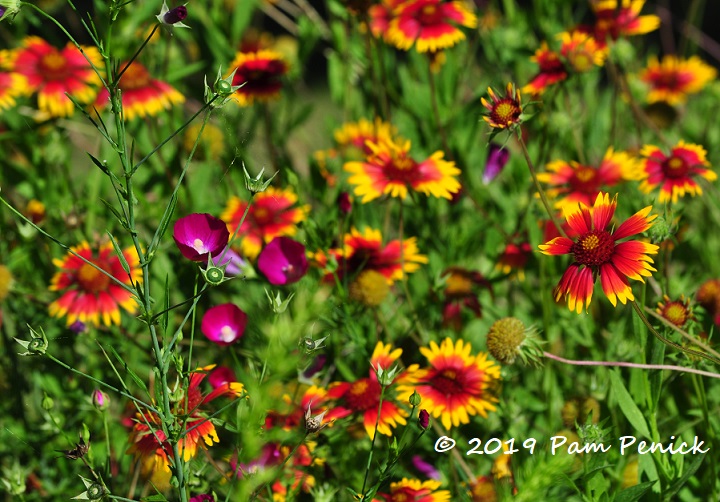
Tall winecup and masses of blanketflower — kapow!
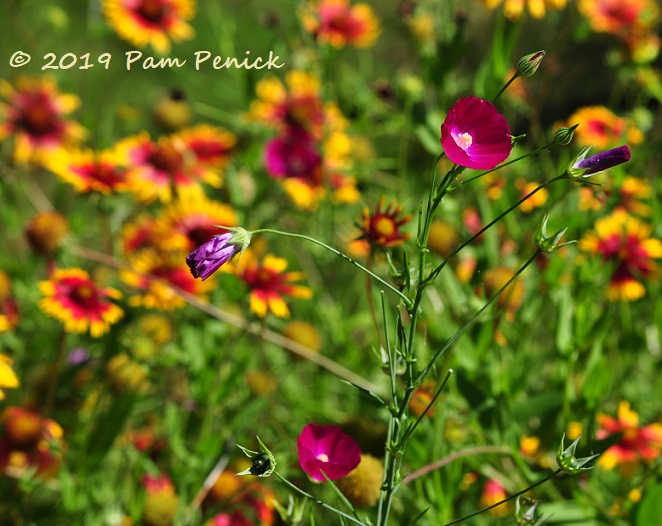
Such a pretty combo.
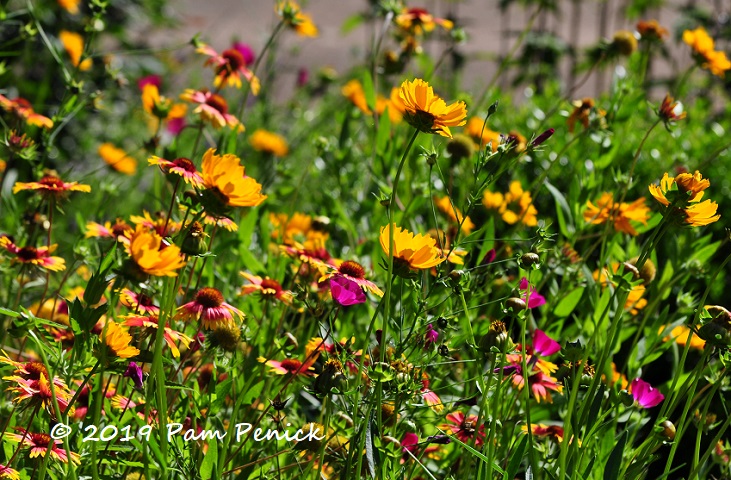
Add golden coreopsis and it glows.
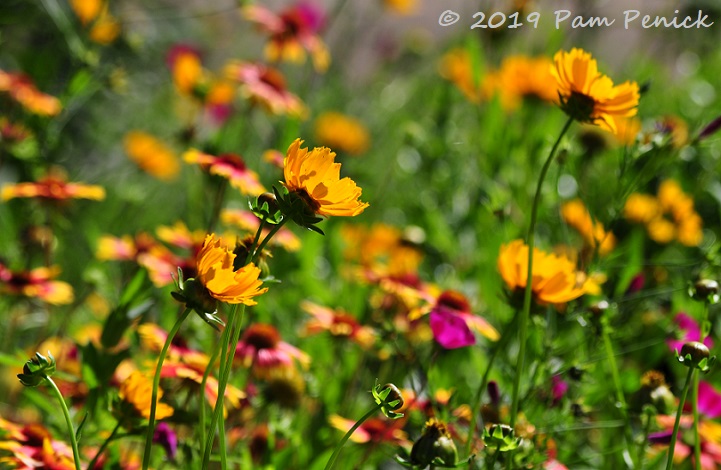
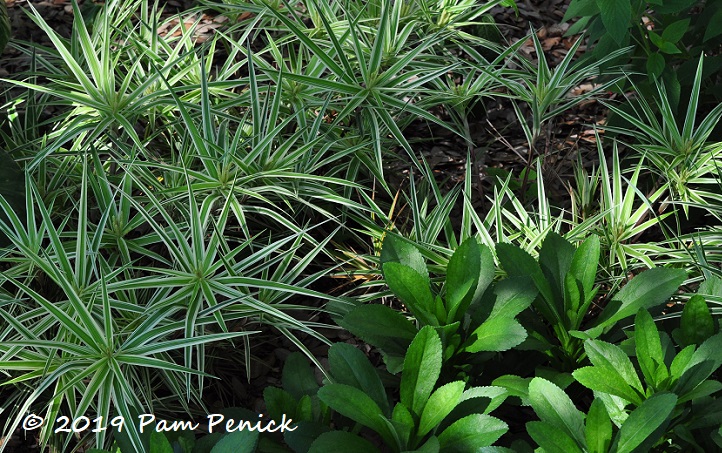
Along the foundation of the house it’s shady, so Cat grows pretty foliage plants like ‘Sparkler’ sedge (shown here), giant leopard plant, and Japanese maple.
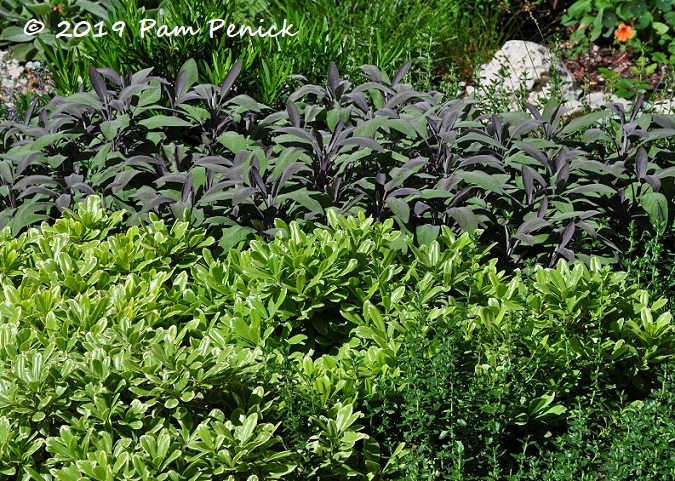
A spot with morning sun glows with low-mounding ‘Cream de Mint’ pittosporum paired with purple-tinged common sage (Salvia officinalis).
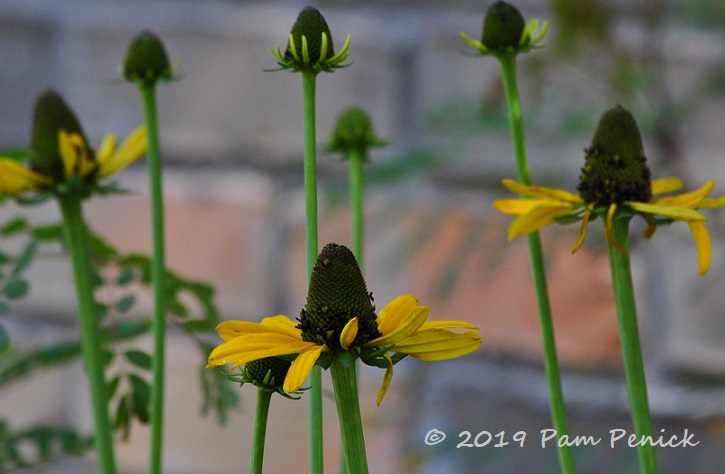
Giant coneflower (Rudbeckia maxima) shoots skyward in the side garden.
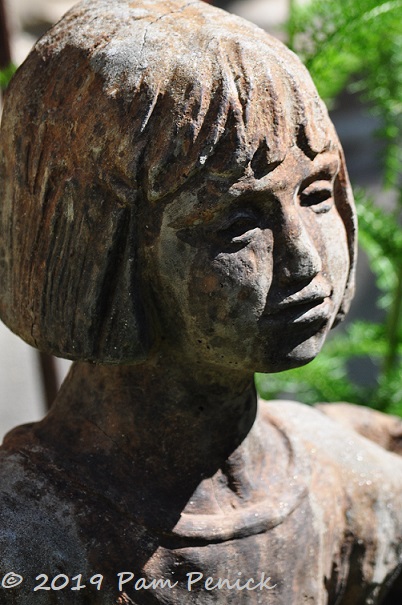
Sweet statuary tucked amid the plants.
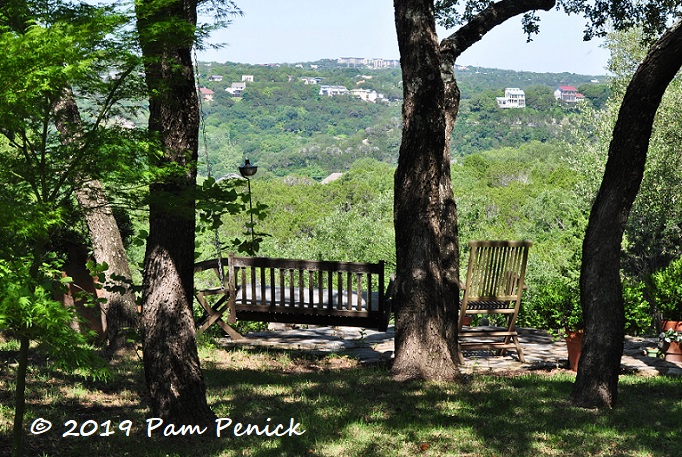
And then you enter the gated backyard to see this: a rustic patio shaded by live oaks and perched on the edge of a canyon, with a view of green hills bumping up against the big Texas sky.
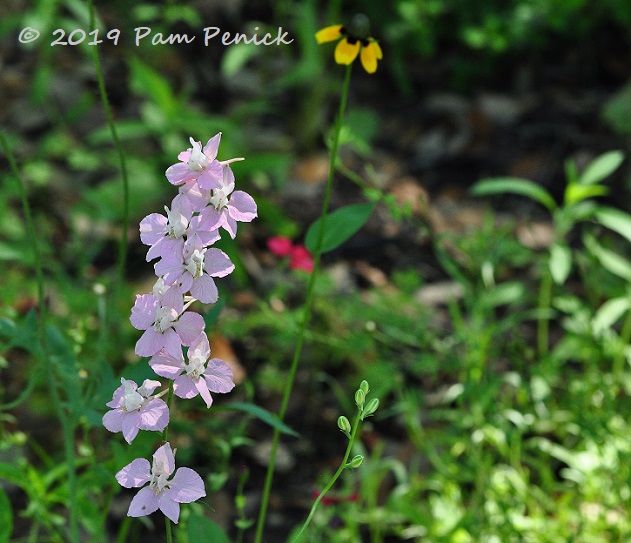
A winding path leads down into the sunny upper canyon, where sown wildflowers like larkspur…
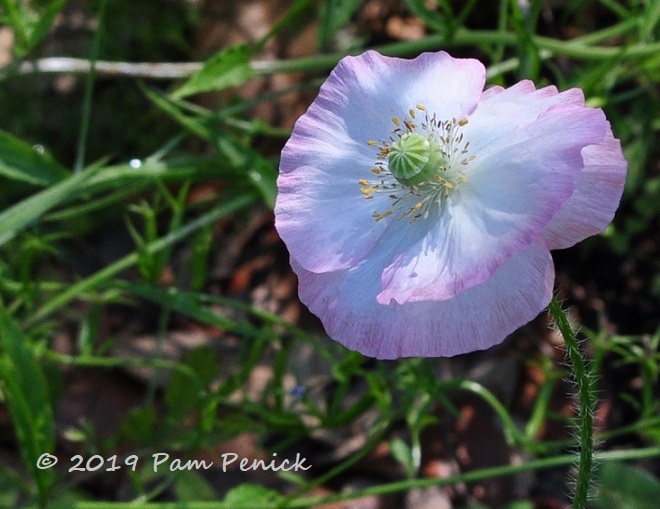
…and poppy mingle with native wildflowers and grasses.
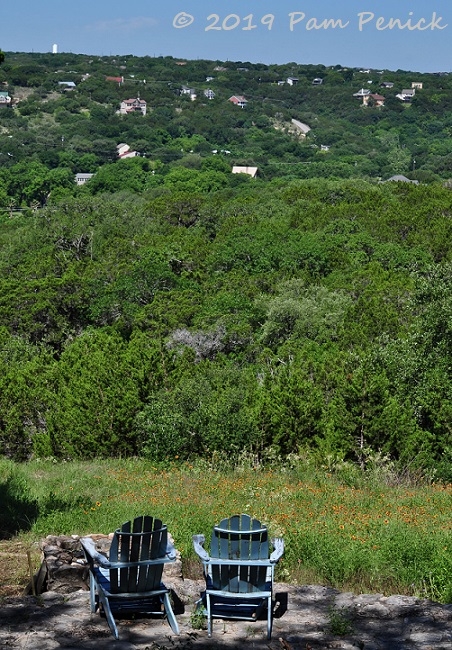
A second patio just above an open meadow contains two Adirondacks overlooking masses of blanketflower and the hills beyond.
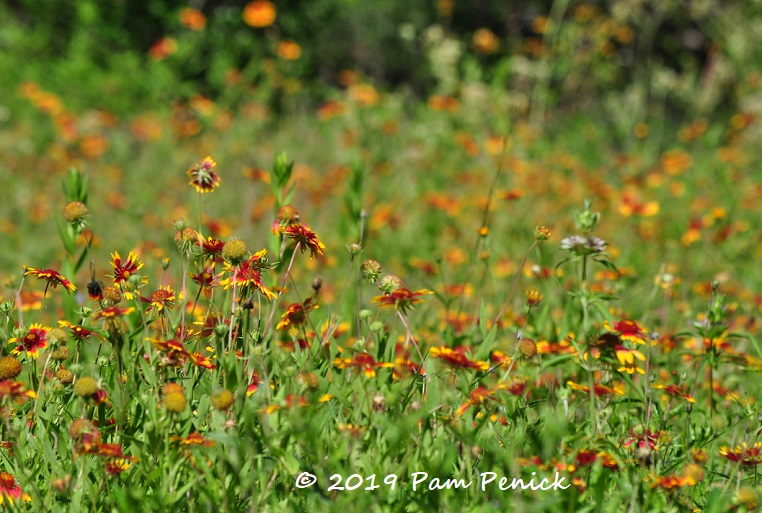
Blanketflower meadow
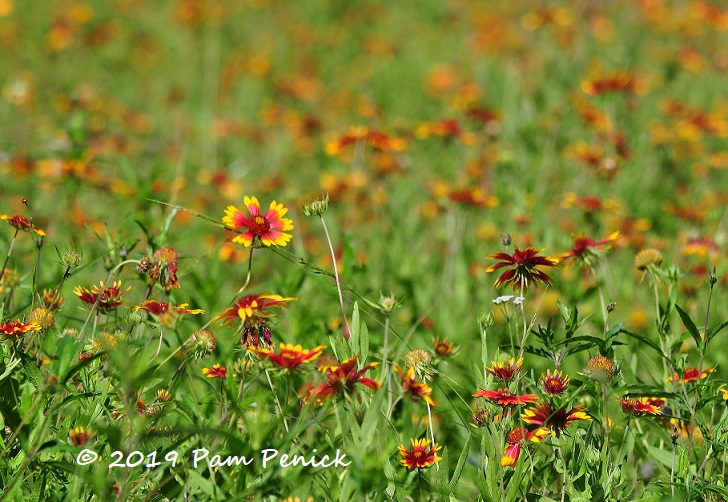
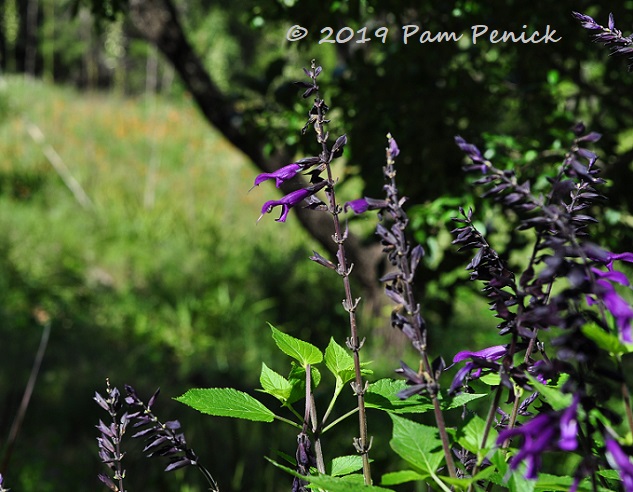
Back up top, a hummingbird and I paused to appreciate ‘Amistad’ salvia. He was too quick for me to capture though.
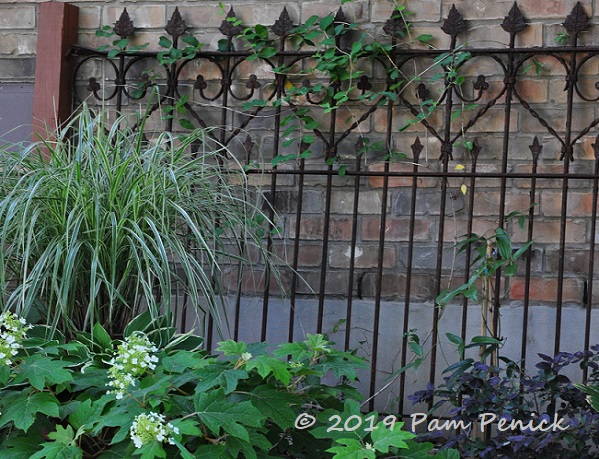
Cat prowls thrift shops for finds like this: a section of wrought-iron fencing, which leans against the house as an impromptu trellis. In front, white-flowering oakleaf hydrangea and white-striped variegated miscanthus brighten this shady spot.
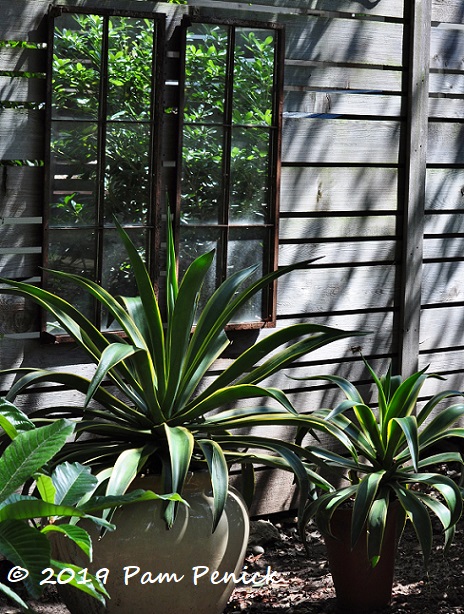
Two potted Agave desmettiana appear to be admiring themselves in twin mirrors hung on the fence.
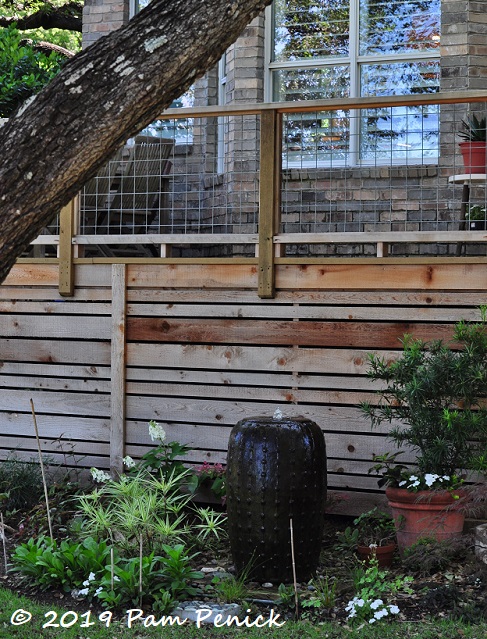
Cat and Derrick updated their existing deck with skirting that matches their new contemporary-style fencing, with horizontal slats of varying widths. Along the base, a tall pot fountain bubbles and beckons to birds that chirp and call all through Cat’s canyon-side garden.
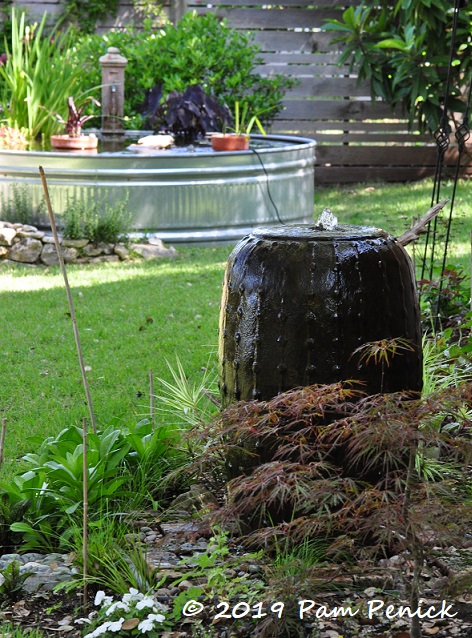
The fountain also “calls” to a large stock-tank pond on the far side of the garden, one water feature riffing on the other.
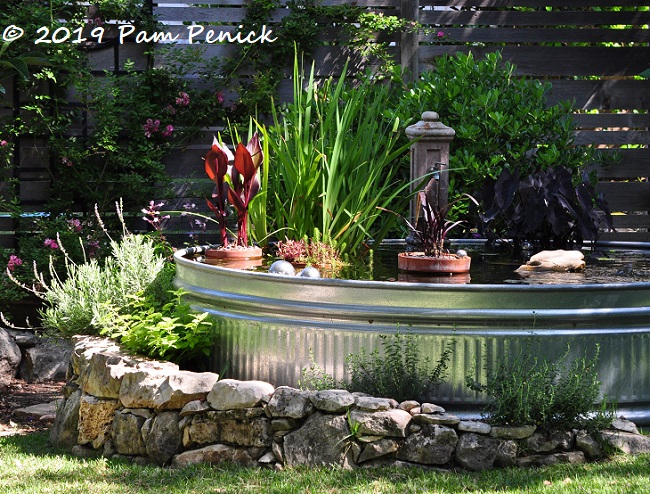
An 8-foot stock tank holds an assortment of nicely potted pond plants with wine-colored foliage. Floating silver balls add sparkle, and a pillar-style fountain adds a soft splashing sound. Cat says she got the stock tank from a family whose children used it as a swimming pool until they outgrew it.
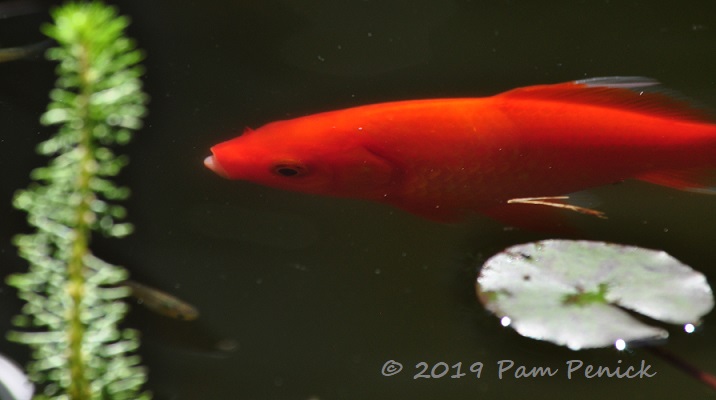
Now the only swimmers are goldfish…
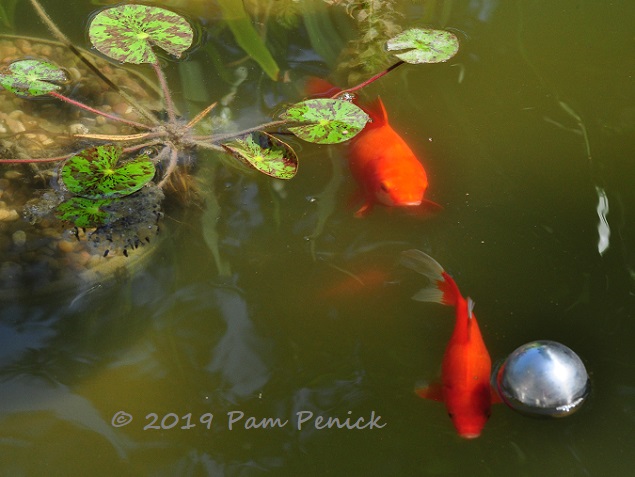
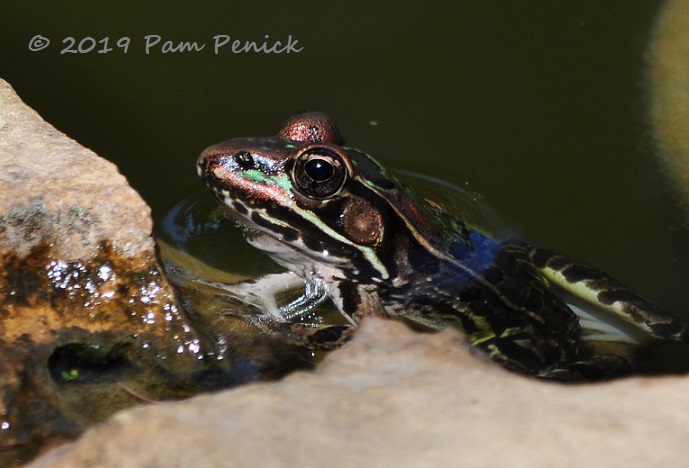
…glistening frogs, and the occasional pesky water snake that tries to eat the more welcome pond denizens.
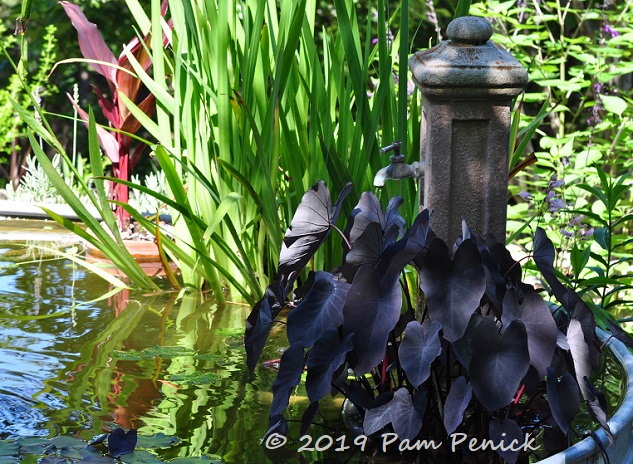
In the late afternoon, slanting sunlight glows through the black elephant ears “like magic,” Cat says.
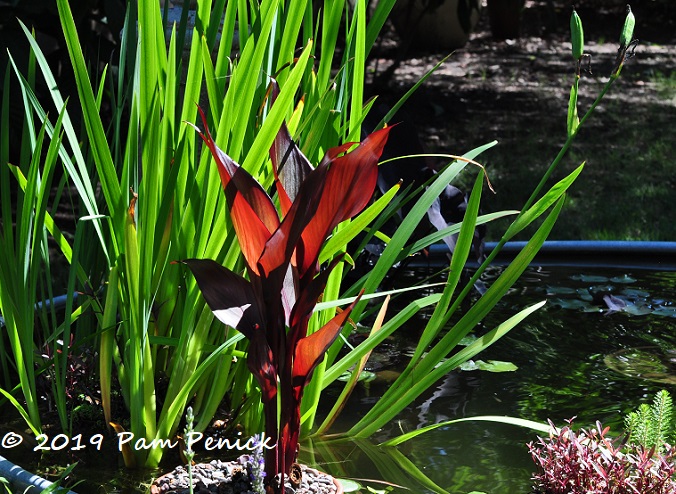
Red canna
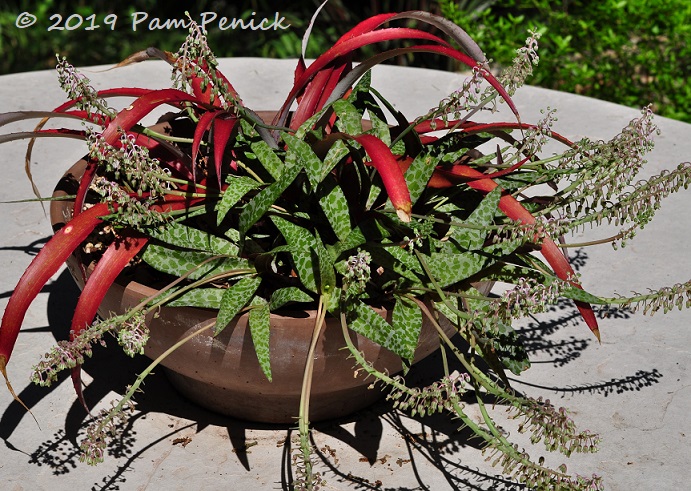
I love Cat’s container combos, like this spidery red bromeliad with spotted squill. Both were passalongs from friends.
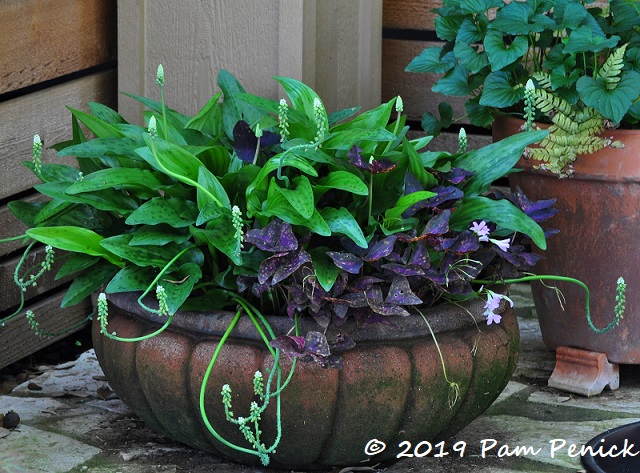
In a shadier spot, African hosta (Drimiopsis maculata) and purple oxalis make a divine pair. I had African hosta in the ground, and it just got lost amid other plants, so I’m taking note of how great it looks in a bowl planter.
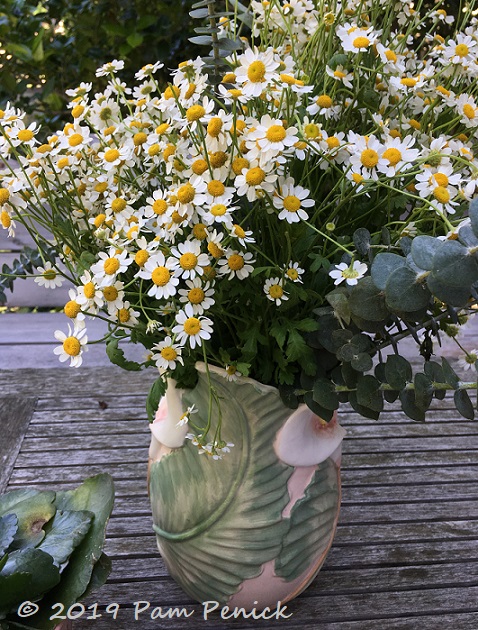
My thanks to Cat for sharing her beautiful garden with me again! It’s been exciting to see it coming into its own as a reflection of her own unique style, in harmony with the canyon that brought them here, to their new home and garden adventure.
__________________________
Digging Deeper
Come learn about gardening and design at Garden Spark! I organize in-person talks by inspiring designers, landscape architects, authors, and gardeners a few times a year in Austin. These are limited-attendance events that sell out quickly, so join the Garden Spark email list to be notified in advance; simply click this link and ask to be added. Season 8 kicks off in fall 2024. Stay tuned for more info!
All material © 2025 by Pam Penick for Digging. Unauthorized reproduction prohibited.


Thank you for sharing your friends garden. It is a knockout. I see a lot of beauty and inspiration here too.
I’m always inspired by her artistic choices.
Wow, Cat’s garden is a knockout! I remember when they first bought the place.
She’s made a lot of progress in the last three years.
What a wonderful view and a beautiful garden! Thanks for sharing your visit, Pam.
My pleasure, Kris!
Thank you for the tour of Cat’s garden, she’s made something very wonderful…and has such a great way with plant combos!
She really does. I always like seeing what she’s doing.
That mangave and rusty water feature are perfect as is the swath of sage. Sometimes it’s the simple things that make the difference.
Simple things, well done, are often the best choice.
Thank you, Pam, for the warm encouragement. It’s been a fun, although sometimes slow, process to build a new garden from nothing but ligustrum, photinia and Bermuda grass! It’s always so enjoyable to see spaces through your lens. Come by anytime for sunset views, you’re always welcome
Thanks, friend! You’ve done so much in three short years. I look forward to seeing your garden continue to evolve and grow.
Beautiful garden tour…love your photography (the toad/frog pic especially). That’s a lot of progress in 3 years. Bravo to Cat & her husband.
Thanks, Sherry. That was a very photogenic frog.
Lovely! Beautiful statuary and I’ve never seen tall winecup!
Thanks for the post.
My pleasure, Wendy!
I loved seeing the Princess Diana clematis. I just bought one last summer at the Antique Rose Emporium near Brenham, TX without having seen one in bloom before. It’s still a tiny thing, so it will be awhile to put on much of a display.
I just wanted to put in a little plug for FireWise principles. For those not in the Austin area, Steiner Ranch was the scene of a devastating wildfire in 2011 that destroyed 23 homes, at the same time the huge Bastrop Complex fire was destroying 1673 homes in communities about an hour away. Fire fighting resources were stretched thin in the area. A few months earlier in 2011, my subdivision was across the hwy from a wildfire that also destroyed structures–but we were lucky the wind was not blowing toward us. There have been many lessons learned from wildfire in the urban/wildland interface. Most structure fires are caused by embers that have traveled up to 3 miles from its source, landed in a leaf-filled gutter or under a wooden deck or into an attic through a vent. A majority of the state of Texas has had wildfires within 2 miles of urban areas. Travis County (where Austin is) is often considered #2 in the nation for wildfire risk. The good news is that it’s possible in a lot of areas to have a Home Ignition Zone Inspection or home Wildfire Risk Assessment by your local forestry service or fire station personnel to assess your property for ways to minimize those possibilities and increase awareness. And/or Google “Home Ignition Zone” for a pdf that takes you through the zones and what to look for to make your property more wildfire resistant. My HOA recently sponsored training (2 to 3 hrs) for community members to become Home Ignition Zone inspectors through the TX A&M Forestry Service, and the county also just held its one-day conference on Wildfire Preparedness, to increase awareness as we go into the hotter, drier summer. The way we landscape can also decrease our vulnerability to structure loss from wildfire and the pdf can give a good amount of information on that.
I think about fire risk a good deal, being in a forested neighborhood on a canyon ridge myself. But I agree that we can all, especially those of us on the west side of town, be thinking much more about firewise landscaping, as Californians have had to do. I pray we never see another wildfire like the one in Bastrop or even the smaller (but still scary) one in Steiner, but odds are we will. As you point out, better to be prepared.